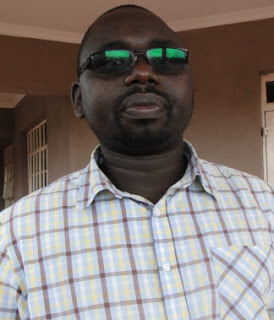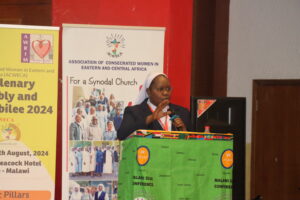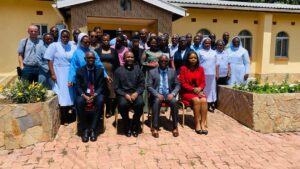KENYA: Diocese of Maralal is working towards Reconciling Warring Communities in Samburu

AMECEA Online
News had an exclusive interview with the Caritas Director from the Diocese of
Maralal Mr Evans Onyiego and will publish in two parts series of the realities of Samburu County
and the Catholic Church’s effort in conjunction with partners to bring peace
and reconciliation as well as provide for humanitarian basic needs to the
communities of Samburu County.
News had an exclusive interview with the Caritas Director from the Diocese of
Maralal Mr Evans Onyiego and will publish in two parts series of the realities of Samburu County
and the Catholic Church’s effort in conjunction with partners to bring peace
and reconciliation as well as provide for humanitarian basic needs to the
communities of Samburu County.
Part One: Understanding
the root causes of Samburu Conflicts
the root causes of Samburu Conflicts
 |
| Mr Evans Onyiego |
Thursday November 12th 2015 will mark
the third anniversary of the killing of the 42 police officer and National Reservists
commonly known as the home guards in the Suguta Valley of Samburu County. The
reality of inter-ethnic conflicts fuelled by cattle rustling among the pastoral
communities of Samburu County and the constant insecurity incidences in the
region not only destabilizes life but also makes it very difficult for pastoral
and evangelization work. The Catholic Diocese of Maralal, which covers the
entire Samburu County, has been working with various international donor
agencies and partners to bring reconciliation among the communities as well as
provide the much needed basic humanitarian services.
the third anniversary of the killing of the 42 police officer and National Reservists
commonly known as the home guards in the Suguta Valley of Samburu County. The
reality of inter-ethnic conflicts fuelled by cattle rustling among the pastoral
communities of Samburu County and the constant insecurity incidences in the
region not only destabilizes life but also makes it very difficult for pastoral
and evangelization work. The Catholic Diocese of Maralal, which covers the
entire Samburu County, has been working with various international donor
agencies and partners to bring reconciliation among the communities as well as
provide the much needed basic humanitarian services.
“The Catholic Diocese of Maralal covers the entire
Samburu County, which is about 21, 000 sq. Km. and when it was inaugurated as a
diocese there was this argument about the name, was it to be the diocese of
Samburu or the Diocese of Maralal? Samburu is an ethnic Community and if the diocese
was to be called Samburu Diocese, it meant that other communities within the
country would have felt excluded. As a result, the Catholic Church settled for
the Diocese of Maralal,” explained Mr. Evans Onyiego, Director of Caritas,
Diocese of Maralal.
Samburu County, which is about 21, 000 sq. Km. and when it was inaugurated as a
diocese there was this argument about the name, was it to be the diocese of
Samburu or the Diocese of Maralal? Samburu is an ethnic Community and if the diocese
was to be called Samburu Diocese, it meant that other communities within the
country would have felt excluded. As a result, the Catholic Church settled for
the Diocese of Maralal,” explained Mr. Evans Onyiego, Director of Caritas,
Diocese of Maralal.
Samburu County from time immemorial has
experienced the inter-ethnic conflicts between the Samburus, the Turkanas and
the Pokot Communities who inhabit the area. These three communities are all
pastoralists with Samburus being the majority in terms of population.
experienced the inter-ethnic conflicts between the Samburus, the Turkanas and
the Pokot Communities who inhabit the area. These three communities are all
pastoralists with Samburus being the majority in terms of population.
According to Onyiego Samburu County is situated on
the Northern part of Kenya. It borders Marsabit, Isiolo, Laikipia and East
Pokot and Turkana and all these regions are inhabited by the pastoralist
communities among who the culture of cattle rustling is a sport.
the Northern part of Kenya. It borders Marsabit, Isiolo, Laikipia and East
Pokot and Turkana and all these regions are inhabited by the pastoralist
communities among who the culture of cattle rustling is a sport.
Onyiego explained that traditionally, during the
olden days, cattle rustling was viewed as a way of warrior-building for the
young Moran. The young Moran had to
engage in the act to prove their strength and maturity towards becoming protectors
of families and community. This used to happen just before they were
circumcised.
olden days, cattle rustling was viewed as a way of warrior-building for the
young Moran. The young Moran had to
engage in the act to prove their strength and maturity towards becoming protectors
of families and community. This used to happen just before they were
circumcised.
Cattle rustling in the past also had the benefit
of cross breeding of livestock. “When a community noticed a breed from their
neighbor that they liked, they would raid the neighborhood and steal the cattle
for breeding purposes of their herd. Though an unconventional way, the
communities were used to such incidences. However the magnitude of injuries and
death during cattle rustling in the past was kept at very low levels because
the kind of weapon used were just some sticks, and may be machete; a scenario
that has completely changed,” He explained adding that the stolen animals
belonged to the community in the past and not individuals, and raids were communally
organized.
of cross breeding of livestock. “When a community noticed a breed from their
neighbor that they liked, they would raid the neighborhood and steal the cattle
for breeding purposes of their herd. Though an unconventional way, the
communities were used to such incidences. However the magnitude of injuries and
death during cattle rustling in the past was kept at very low levels because
the kind of weapon used were just some sticks, and may be machete; a scenario
that has completely changed,” He explained adding that the stolen animals
belonged to the community in the past and not individuals, and raids were communally
organized.
Things have dramatically changed over the years
and according to Onyiego, cattle rustling is no longer a community affair,
neither is it for cross-breeding nor warrior-building, it is more of economically
instigated. At the same time the kind of weaponry used during today’s raids are
very crude and lethal. “The kind of raids happening now is about two or three
people going to raid for their own benefit. Something that is an outright theft,”
he said. People raid so that they can sell the animals, something that was
unheard of in the past; and use the proceeds to maintain a certain kind of lifestyle
that is very expensive, for instance where people need to have expensive mobile
phones, drinking beer, and idle around.
and according to Onyiego, cattle rustling is no longer a community affair,
neither is it for cross-breeding nor warrior-building, it is more of economically
instigated. At the same time the kind of weaponry used during today’s raids are
very crude and lethal. “The kind of raids happening now is about two or three
people going to raid for their own benefit. Something that is an outright theft,”
he said. People raid so that they can sell the animals, something that was
unheard of in the past; and use the proceeds to maintain a certain kind of lifestyle
that is very expensive, for instance where people need to have expensive mobile
phones, drinking beer, and idle around.
Onyiego also said that cattle rustling that are
happening today can also be attributed to political reasons. He said that some
politicians allegedly use the raids to gain political supremacy and win voters.
“Basically it is the politicians who are benefiting out of these conflicts. You
keep people in a state of fear everywhere then come and tell them that you will
help them get rid of their enemies.” He said that there have been many
allegations that some politicians fund the conflicts or distributing bullets
and guns to fight ‘the perceived enemy’ and appear heroes of the region.
happening today can also be attributed to political reasons. He said that some
politicians allegedly use the raids to gain political supremacy and win voters.
“Basically it is the politicians who are benefiting out of these conflicts. You
keep people in a state of fear everywhere then come and tell them that you will
help them get rid of their enemies.” He said that there have been many
allegations that some politicians fund the conflicts or distributing bullets
and guns to fight ‘the perceived enemy’ and appear heroes of the region.
Another factor that instigates cattle rustling is marginalization
of the region, which is also linked to politics. Samburu County, which is where
Maralal Diocese is, is one of the most marginalized counties where basic
infrastructure such as good roads, schools and health facilities are almost
none-existent. Because of lack of development the majority of young people
including children are introduced to the gun. The lack of presence of
government in those areas means people have to protect themselves basically and
the use of guns become handy. The law of demand and supply is another aspect
that contributes to cattle rustling in Samburu County. “Those who are trading
on guns and ammunitions have to create a demand so that their supply remains
constant,” Onyiego explained.
of the region, which is also linked to politics. Samburu County, which is where
Maralal Diocese is, is one of the most marginalized counties where basic
infrastructure such as good roads, schools and health facilities are almost
none-existent. Because of lack of development the majority of young people
including children are introduced to the gun. The lack of presence of
government in those areas means people have to protect themselves basically and
the use of guns become handy. The law of demand and supply is another aspect
that contributes to cattle rustling in Samburu County. “Those who are trading
on guns and ammunitions have to create a demand so that their supply remains
constant,” Onyiego explained.
“Government effort to disarm the communities is a
futile approach because it only leaves the communities vulnerable to the
attacks. It is more important to first provide the much needed structures to
ensure security and development of the communities and this is what the
Catholic Church in Maralal Diocese is working towards achieving albeit slowly,”
Onyiego concludes
futile approach because it only leaves the communities vulnerable to the
attacks. It is more important to first provide the much needed structures to
ensure security and development of the communities and this is what the
Catholic Church in Maralal Diocese is working towards achieving albeit slowly,”
Onyiego concludes
End of Part One; Next week AMECEA Online News will continue with the interventions of the
Catholic Church in Samburu towards bringing reconciliation and hope of a
lasting peace among the communities of Samburu County.
Catholic Church in Samburu towards bringing reconciliation and hope of a
lasting peace among the communities of Samburu County.
By Pamela
Adinda, AMECEA Online News
Adinda, AMECEA Online News


